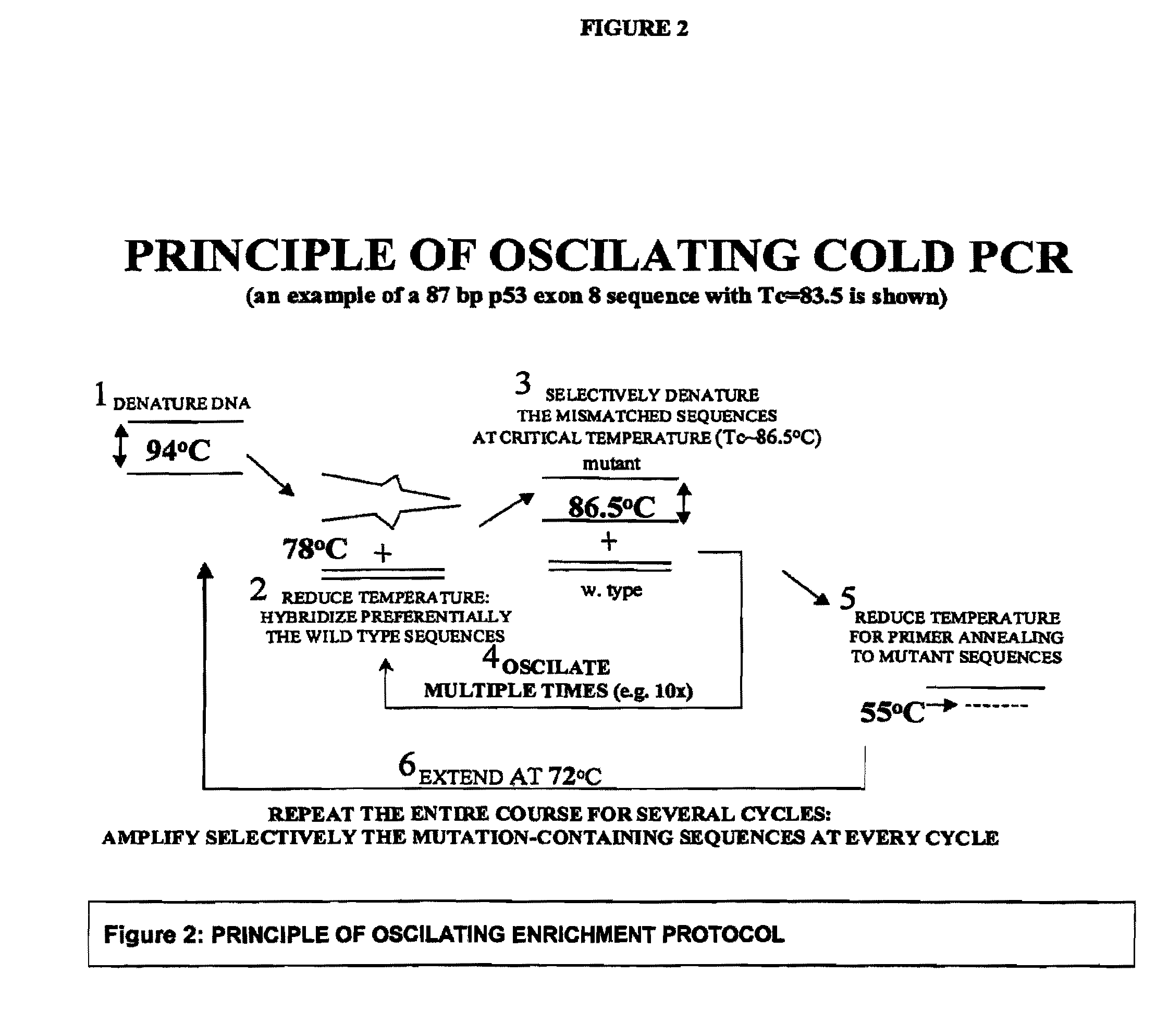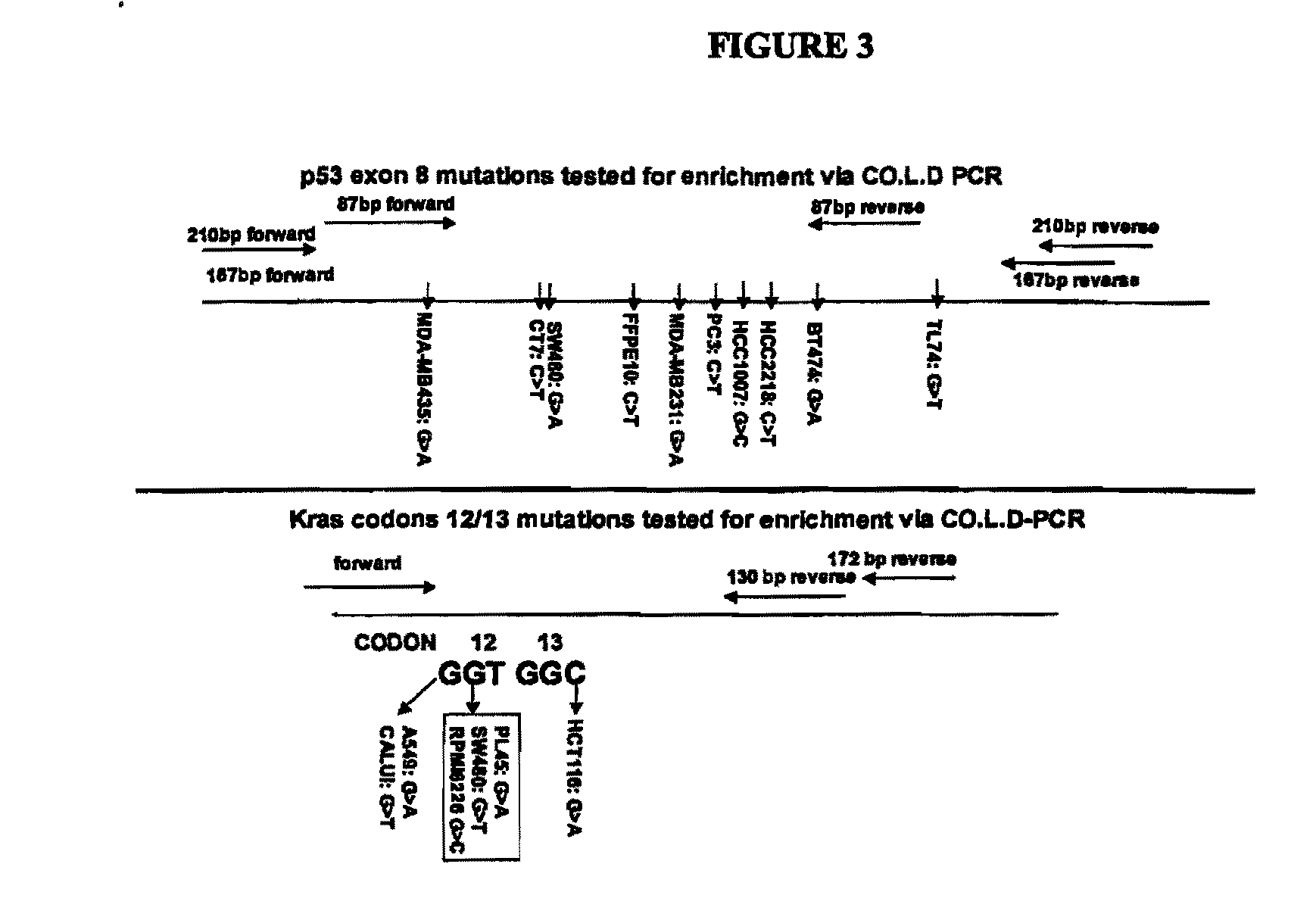Enrichment of a Target Sequence
a target sequence and enrichment technology, applied in the field of enrichment of target sequences, can solve the problems of low-prevalence somatic mutation detection in tumors with heterogeneity, stromal contamination or bodily fluid contamination, and still requires laborious micro-dissection, so as to achieve the effect of greatly improving the detection limits of all pcr-based technologies
- Summary
- Abstract
- Description
- Claims
- Application Information
AI Technical Summary
Benefits of technology
Problems solved by technology
Method used
Image
Examples
example 1
Materials and Methods for Enriching a Target Sequence
[0154]Sequences used for validation of COLD-PCR: To validate the present invention, a series of genomic DNA and cell lines containing mutations at different positions of p53 exon 8 and Kras exon 2 (codons 12-13) were used (FIG. 3). The p53 exon 8 mutations correlate with poor prognosis in lung cancer and are low-prevalence mutations in the plasma of cancer patients. Similarly, Kras mutations have prognostic significance in lung adenocarcinoma.
[0155]Enrichment protocol and primers: PCR was performed in the presence of 0.1× LC-Green intercalating dye and followed in real-time in a Cepheid machine. Real-time-follow-up of PCR is not necessary but is convenient so it was adopted for all experiments.
[0156]For the 167 by p53 sequence normal PCR was first performed for 10 cycles in order to generate sufficient product for use in the enrichment protocol. A Cepheid machine was programmed with the following cycling parameters: 95° C., 120 se...
example 2
Sanger Sequencing of Clinical Samples
[0163]To apply the present invention for the analysis of clinical samples, 20 colon tumor and lung adenocarcinoma clinical samples that were previously sequenced following regular PCR were subjected to the enrichment protocol and sanger sequencing as described in Example 1. Results indicated that all mutations identified via regular PCR-Sanger sequencing were also identified via the enrichment procedure followed by sequencing. However, the enrichment procedure also identified mutations that were missed by regular sequencing. FIG. 6 depicts 2 clinical samples, TL64 and CT20, where low-prevalence G>A mutations were detected via the enrichment protocol-Sanger sequencing of p53 exon 8, codon 273, but which were not detected by sequencing following regular PCR. An independent verification of the presence of mutations was conducted using RFLP-based sequencing.
[0164]Further, a p53 exon 8 (G>A) mutation was detected in plasma-circulating DNA from 5 colon...
example 3
Mutations that Decrease the Tm can be Enriched without the Mismatch Annealing Step
[0165]The dependence of PCR on the nucleotide sequence is so pronounced when the denaturation temperature is set at the critical temperature (Tc) that even without forming a mismatch during PCR there is enrichment of those mutations that decrease the Tm. Thus, when a G and an A allele are present, the A-allele will be enriched during COLD-PCR as this decreases the Tm of the allele. To demonstrate this point, and to also examine the dependence of the enrichment on the size of the examined sequence, an 87 by fragment and a 210 by fragment containing the same mutations as the 167 by fragment from p53 exon 8 were examined (FIG. 3). As with the 167 by fragment, these two fragments were amplified from the initial p53 exon 8 amplicon via nested PCR followed by the enrichment protocol. However, in this case a truncated version of the amplification protocol of Example 1 was used, but the mismatch-forming step a...
PUM
| Property | Measurement | Unit |
|---|---|---|
| Tc | aaaaa | aaaaa |
| temperature | aaaaa | aaaaa |
| melting temperature | aaaaa | aaaaa |
Abstract
Description
Claims
Application Information
 Login to View More
Login to View More - R&D
- Intellectual Property
- Life Sciences
- Materials
- Tech Scout
- Unparalleled Data Quality
- Higher Quality Content
- 60% Fewer Hallucinations
Browse by: Latest US Patents, China's latest patents, Technical Efficacy Thesaurus, Application Domain, Technology Topic, Popular Technical Reports.
© 2025 PatSnap. All rights reserved.Legal|Privacy policy|Modern Slavery Act Transparency Statement|Sitemap|About US| Contact US: help@patsnap.com



